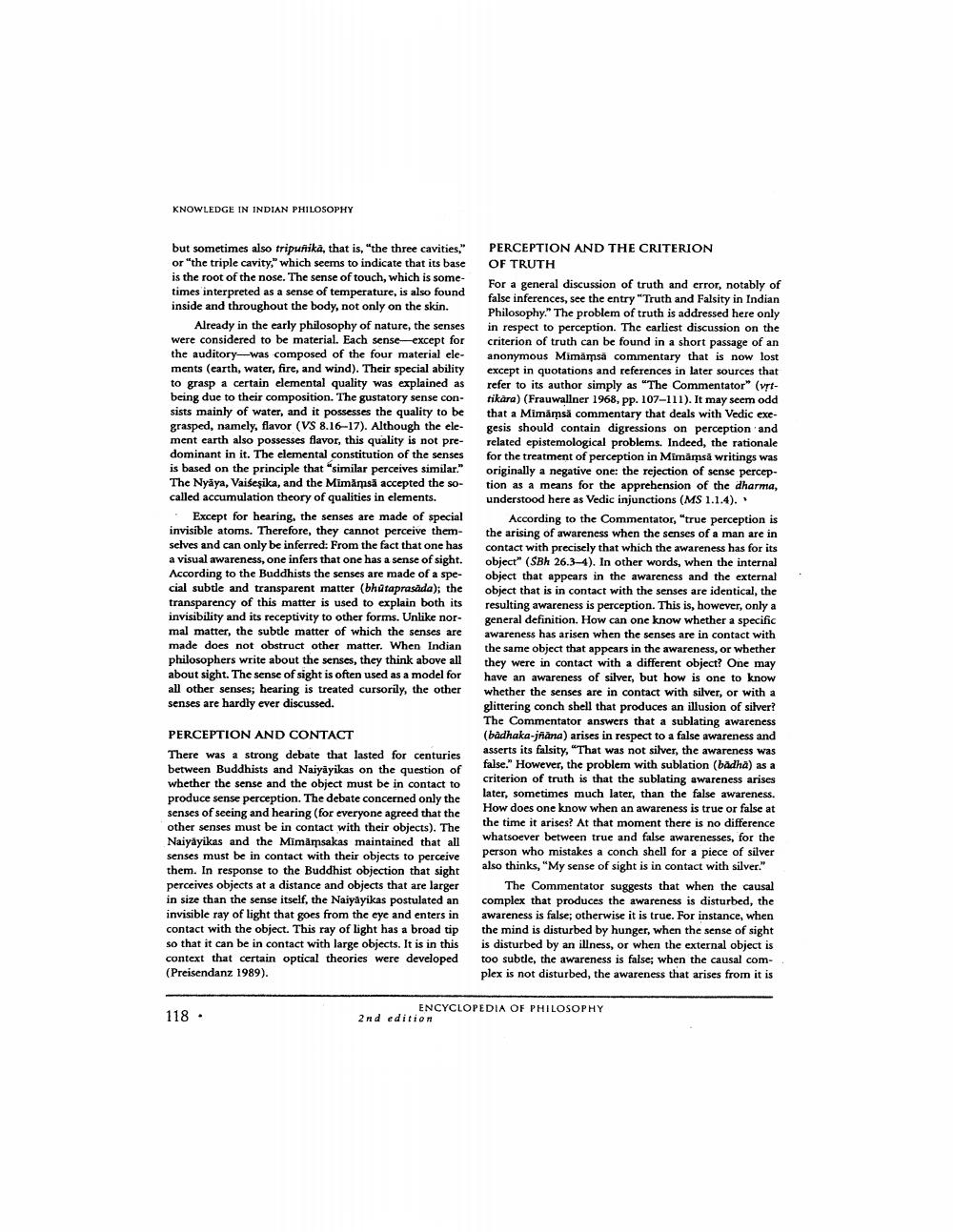Book Title: Knowledge In Indian Philosophy Author(s): Publisher: View full book textPage 4
________________ KNOWLEDGE IN INDIAN PHILOSOPHY but sometimes also tripunika, that is, the three cavities," or "the triple cavity," which seems to indicate that its base is the root of the nose. The sense of touch, which is sometimes interpreted as a sense of temperature, is also found inside and throughout the body, not only on the skin. Already in the early philosophy of nature, the senses were considered to be material. Each sense except for the auditory-was composed of the four material elements (earth, water, fire, and wind). Their special ability to grasp a certain elemental quality was explained as being due to their composition. The gustatory sense consists mainly of water, and it possesses the quality to be grasped, namely, flavor (VS 8.16-17). Although the element earth also possesses flavor, this quality is not predominant in it. The elemental constitution of the senses is based on the principle that "similar perceives similar." The Nyaya, Vaisesika, and the Mimamsa accepted the socalled accumulation theory of qualities in elements. * Except for hearing, the senses are made of special invisible atoms. Therefore, they cannot perceive themselves and can only be inferred: From the fact that one has a visual awareness, one infers that one has a sense of sight. According to the Buddhists the senses are made of a special subtle and transparent matter (bhutaprasada); the transparency of this matter is used to explain both its invisibility and its receptivity to other forms. Unlike normal matter, the subtle matter of which the senses are made does not obstruct other matter. When Indian philosophers write about the senses, they think above all about sight. The sense of sight is often used as a model for all other senses; hearing is treated cursorily, the other senses are hardly ever discussed. PERCEPTION AND THE CRITERION OF TRUTH For a general discussion of truth and error, notably of false inferences, see the entry "Truth and Falsity in Indian Philosophy." The problem of truth is addressed here only in respect to perception. The earliest discussion on the criterion of truth can be found in a short passage of an anonymous Mimamsa commentary that is now lost except in quotations and references in later sources that refer to its author simply as "The Commentator" (vsttikara) (Frauwallner 1968, pp. 107-111). It may seem odd that a Mimamsa сommentary that deals with Vedic exegesis should contain digressions on perception and related epistemological problems. Indeed, the rationale for the treatment of perception in Mimamsa writings was originally a negative one: the rejection of sense perception as a means for the apprehension of the dharma, understood here as Vedic injunctions (MS 1.1.4). According to the Commentator, "true perception is the arising of awareness when the senses of a man are in contact with precisely that which the awareness has for its object" (SBh 26.3-4). In other words, when the internal object that appears in the awareness and the external object that is in contact with the senses are identical, the resulting awareness is perception. This is, however, only a general definition. How can one know whether a specific awareness has arisen when the senses are in contact with the same object that appears in the awareness, or whether they were in contact with a different object? One may have an awareness of silver, but how is one to know whether the senses are in contact with silver, or with a glittering conch shell that produces an illusion of silver? The Commentator answers that a sublating awareness (badhaka-jnana) arises in respect to a false awareness and asserts its falsity, "That was not silver, the awareness was false." However, the problem with sublation (badha) as a criterion of truth is that the sublating awareness arises later, sometimes much later, than the false awareness. How does one know when an awareness is true or false at the time it arises? At that moment there is no difference whatsoever between true and false awarenesses, for the person who mistakes a conch shell for a piece of silver also thinks, "My sense of sight is in contact with silver." The Commentator suggests that when the causal complex that produces the awareness is disturbed, the awareness is false; otherwise it is true. For instance, when the mind is disturbed by hunger, when the sense of sight is disturbed by an illness, or when the external object is too subtle, the awareness is false; when the causal complex is not disturbed, the awareness that arises from it is PERCEPTION AND CONTACT There was a strong debate that lasted for centuries between Buddhists and Naiyayikas on the question of whether the sense and the object must be in contact to produce sense perception. The debate concerned only the senses of seeing and hearing (for everyone agreed that the other senses must be in contact with their objects). The Naiyayikas and the Mimamsakas maintained that all senses must be in contact with their objects to perceive them. In response to the Buddhist objection that sight perceives objects at a distance and objects that are larger in size than the sense itself, the Naiyayikas postulated an invisible ray of light that goes from the eye and enters in contact with the object. This ray of light has a broad tip so that it can be in contact with large objects. It is in this context that certain optical theories were developed (Preisendanz 1989). 118 . ENCYCLOPEDIA OF PHILOSOPHY 2nd editionPage Navigation
1 2 3 4 5 6 7 8 9
